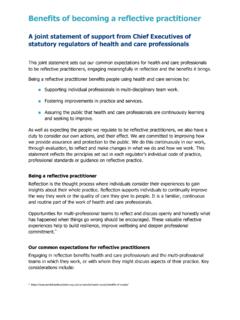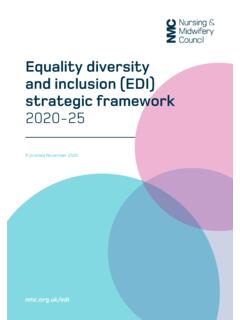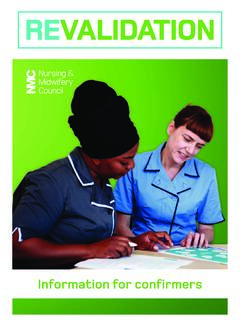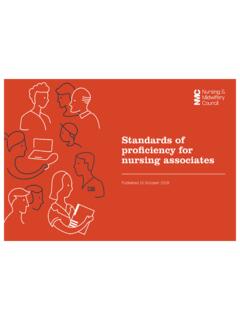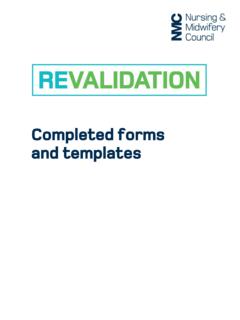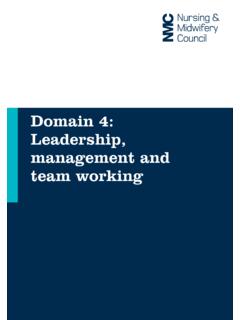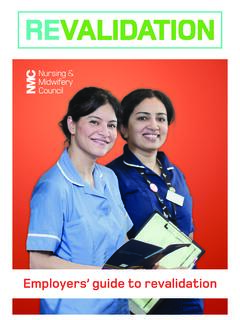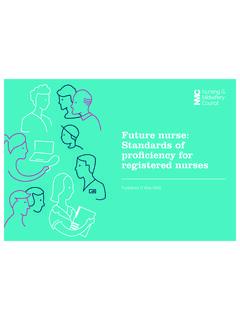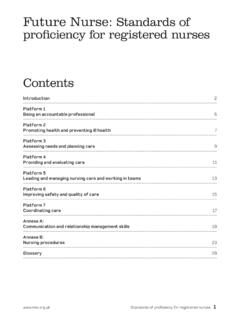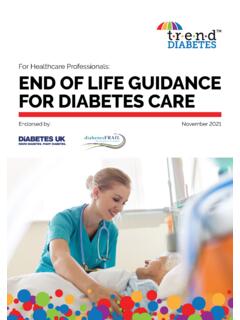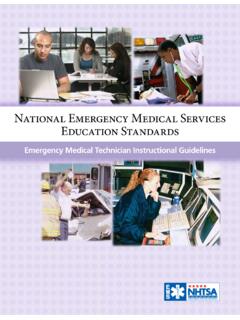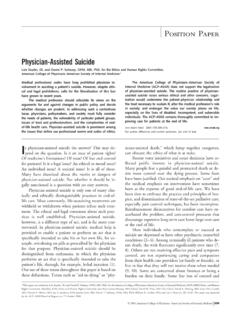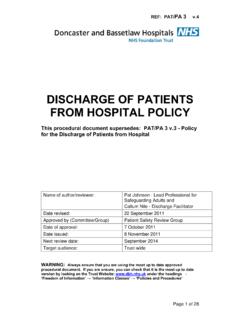Transcription of WORKING DRAFT Nursing associate skills annexe
1 Page 1 WORKING DRAFTN ursing associate skills annexePart of the DRAFT standards of proficiency for Nursing associatesDRAFT1 WORKING DRAFT version of the Nursing associate skills annexe , part of the DRAFT Nursing associate standards of proficiency This WORKING DRAFT of the skills annexe is being released to allow people to see how the skills annexe is developing and what it contains. We will update this DRAFT and release a new version for consultation in April 2018. The skills annexe will form part of the standards of proficiency for Nursing associates. It s important to remember that this is an early DRAFT of the skills annexe and it may change in response to the feedback we receive before the public consultation on the Nursing associate standards of proficiency.
2 Please be clear about the status of this DRAFT when you are discussing them with your colleagues. DRAFT2 annexe A: Communication and relationship management skills Introduction In order to meet the proficiency outcomes outlined in the main body of this document, Nursing associates must be able to demonstrate the communication and relationship management skills described in this annexe at the point of registration. The ability to communicate effectively, with sensitivity and compassion, and to manage relationships with people is central to the provision of high quality person-centred care. These competencies must be demonstrated in practice settings and adapted to meet the needs of people across their lifespan.
3 Nursing associates need a diverse range of communication skills and strategies to ensure that individuals, their families and carers are supported to be actively involved in their own care wherever appropriate, and that they are kept informed and well prepared. Where people have special communication needs or a disability, it is essential that Nursing associates make reasonable adjustments. This means they ll be able to provide and share information in a way that promotes good health and health outcomes and does not prevent people from having equal access to the highest quality of care. The skills listed below are those that all Nursing associates are expected to demonstrate at the point of registration.
4 DRAFT3 Communication and relationship management for providing and monitoring care 1. Underpinning communication skills a) actively listen, recognise and respond to verbal and non-verbal cues b) use prompts and provide positive verbal and non-verbal reinforcement c) use appropriate non-verbal communication including touch, eye contact and sensitivity to personal space d) use appropriate open and closed questioning e) speak clearly and accurately f) use caring conversation techniques g) check understanding and use clarification techniques h) be aware of own potential bias in communication encounters i) write accurately, clearly and legibly j) provide clear verbal, digital or written information and instructions when delegating or handing over responsibility for care k) recognise the need for, and facilitate access to, translator services and material.
5 2. Communication skills for supporting people to prevent ill health and manage their health challenges a) Share information and check understanding about: preventative health behaviours that help people to make lifestyle choices and improve their own health and wellbeing a range of common conditions including: anxiety, depression, diabetes, dementia, asthma, cardiac disease, chronic obstructive pulmonary d isease, cancer, skin problems, immune deficiencies, psychosis, stroke and arthritis in accordance with care plans. b) clearly and confidently explain to the individual and family how their lifestyle choices may influence their future health . This includes the impact of common health risk behaviours including smoking, obesity, sexual practice, alcohol and substance use c) use clear language and appropriate written materials to support people s understanding of what has caused their health condition and the implications for care and treatments DRAFT4 d) use repetition and positive reinforcement strategies e) recognise sensory impairments including sight, speech and hearing and adopt appropriate communication strategies f) support and monitor the use of personal communication aids including hearing aids, visual aids and voice enhancers g)
6 Address and respond to people s questions, recognising when to refer to others in order to provide accurate responses h) provide support to people so they can access and use a range of augmentative communication techniques including sign language, visual aids signage, magnification and digital communication i) engage in difficult conversations where relevant with support from others, helping people who are feeling vulnerable or in distress, conveying compassion, sensitivity and using appropriate communication strategies. 3. Communication skills for therapeutic intervention a) identify the need for and use appropriate approaches to develop therapeutic relationships with people b) demonstrate the use of a variety of effective communication strategies: reassurance and affirmation de-escalation strategies and techniques distraction and diversion strategies positive behaviour support approaches.
7 4. Communication skills for WORKING in professional teams Demonstrate effective skills when WORKING in teams through: a) active listening when receiving feedback and when dealing with team members concerns and anxieties b) timely and appropriate escalation c) a calm presence when exposed to situations involving conflict d) appropriate and effective confrontation strategies e) de-escalation strategies and techniques when dealing with conflict. DRAFT5 Demonstrate effective supervision and coaching skills by providing: a) clear instructions and explanations when supervising others b) clear instructions and checking understanding when delegating care responsibilities to others c) clear constructive feedback in relation to care delivered by others d) encouragement to colleagues that helps them to reflect on their practice.
8 DRAFT6 annexe B: Procedures to be undertaken by the Nursing associate1 Introduction In order to meet the proficiency outcomes outlined in the main body of this document, Nursing associates must be able to carry out the procedures described in this annexe at the point of their registration. The ability to carry out these procedures, safely, effectively, with sensitivity and compassion (while demonstrating the communication and relationship management skills described in annexe A) is crucial to the provision of person-centred care. These procedures must be demonstrated in a range of practice settings with people across their lifespan. They must be carried out in a way that reflects cultural awareness and ensures that the needs, priorities, expertise and preferences of individuals and their families and carers are always valued.
9 1 In addition to the procedures included in this annexe , some people have proposed that the following should also be included (we have not included them in this current WORKING DRAFT but may consult on their inclusion in April 2018): insertion and removal of oral/ nasal gastric tubes insertion and removal of catheters (all genders) administration of medicines via the intramuscular route use or management of infusion pumps DRAFT7 1. Procedures to enable effective monitoring of a person s condition a) demonstrate effective approaches to monitoring signs and symptoms of physical, mental, cognitive, behavioural and emotional distress, deterioration and improvement Demonstrate the ability to.
10 B) accurately measure weight and height, calculate body mass index, recognise healthy ranges and the clinical significance of low and high readings c) use manual techniques and electronic devices to take, record and interpret vital signs including temperature, pulse, respiration (TPR), blood pressure (BP) and pulse oximetry in order to identify signs of improvement, deterioration or concern d) undertake venepuncture, cannulation, blood sampling, and routine ECG recording e) undertake urinalysis, and blood glucose monitoring and interpret results f) collect and observe sputum, urine and stool specimens g) recognise signs of mental, emotional or physical abuse h) undertake and interpret basic neurological observations i) recognise and take immediate action to manage burns, choking, haemorrhage, neck injury, fitting, seizures and anaphylaxis j) administer basic mental health first aid k) administer basic physical first aid.

